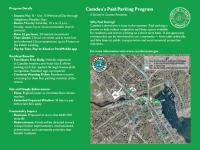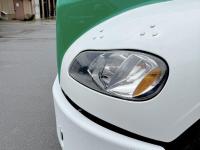Newly Plush: Mitsubishi Outlander SEL 2.5 S-AWC
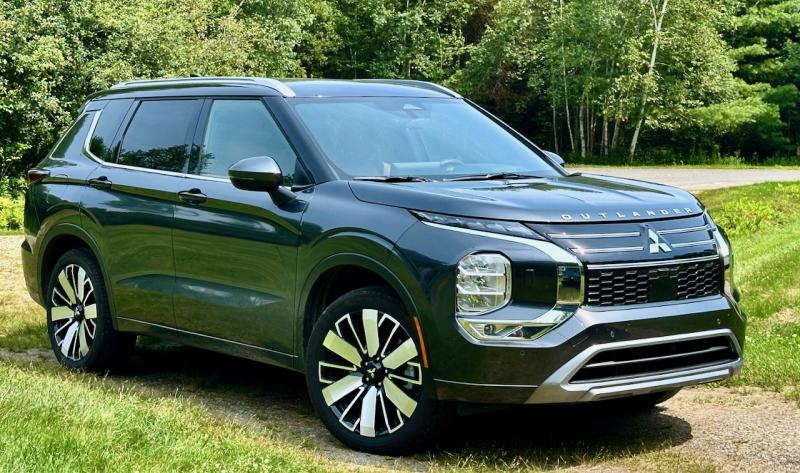 For 2025, Mitsubishi carried out a mid-cycle refresh of the 2022 generation of its compact SUV, the Outlander, with styling tweaks, slightly more power, upgrades to the cabin and infotainment systems, and a re-tune of the suspension for a smoother, quieter ride. It is available as a gas-burner or a plug-in hybrid. It’s hard to tell here, but this color is Graphite Gray with a black roof.
For 2025, Mitsubishi carried out a mid-cycle refresh of the 2022 generation of its compact SUV, the Outlander, with styling tweaks, slightly more power, upgrades to the cabin and infotainment systems, and a re-tune of the suspension for a smoother, quieter ride. It is available as a gas-burner or a plug-in hybrid. It’s hard to tell here, but this color is Graphite Gray with a black roof.
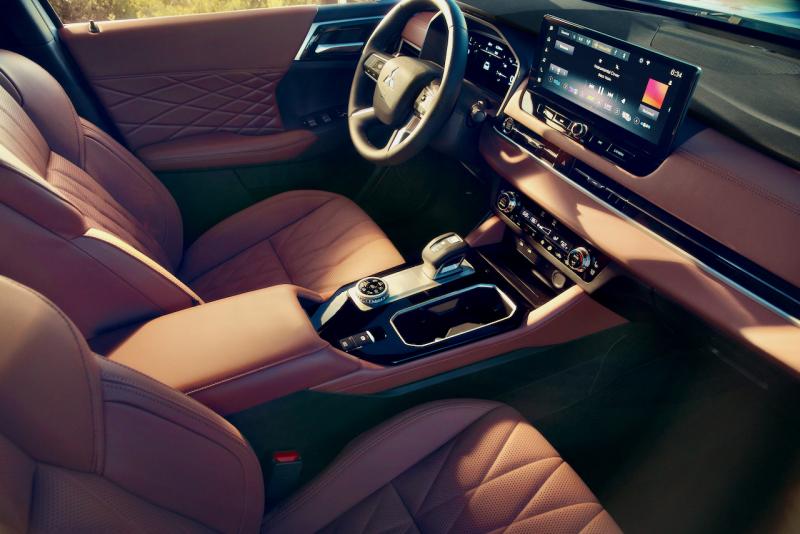 For 2025 the Outlander’s cabin was upgraded with premium-looking upholstery and other materials along with this 12.3-inch touchscreen. The satisfyingly mechanical-feeling push-pull gear selector has the Park button on top, and the e-brake switch is right there on the center console. The knob next to the drink-holder cubby is the drive-mode selector.
For 2025 the Outlander’s cabin was upgraded with premium-looking upholstery and other materials along with this 12.3-inch touchscreen. The satisfyingly mechanical-feeling push-pull gear selector has the Park button on top, and the e-brake switch is right there on the center console. The knob next to the drink-holder cubby is the drive-mode selector.
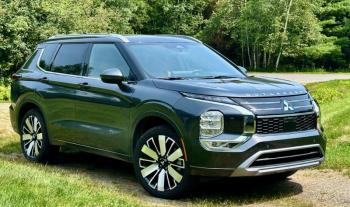 For 2025, Mitsubishi carried out a mid-cycle refresh of the 2022 generation of its compact SUV, the Outlander, with styling tweaks, slightly more power, upgrades to the cabin and infotainment systems, and a re-tune of the suspension for a smoother, quieter ride. It is available as a gas-burner or a plug-in hybrid. It’s hard to tell here, but this color is Graphite Gray with a black roof.
For 2025, Mitsubishi carried out a mid-cycle refresh of the 2022 generation of its compact SUV, the Outlander, with styling tweaks, slightly more power, upgrades to the cabin and infotainment systems, and a re-tune of the suspension for a smoother, quieter ride. It is available as a gas-burner or a plug-in hybrid. It’s hard to tell here, but this color is Graphite Gray with a black roof.
 For 2025 the Outlander’s cabin was upgraded with premium-looking upholstery and other materials along with this 12.3-inch touchscreen. The satisfyingly mechanical-feeling push-pull gear selector has the Park button on top, and the e-brake switch is right there on the center console. The knob next to the drink-holder cubby is the drive-mode selector.
For 2025 the Outlander’s cabin was upgraded with premium-looking upholstery and other materials along with this 12.3-inch touchscreen. The satisfyingly mechanical-feeling push-pull gear selector has the Park button on top, and the e-brake switch is right there on the center console. The knob next to the drink-holder cubby is the drive-mode selector.
It’s been a while, Outlander—nice to see you back in the driveway, and all growed up, too. Once upon a time, this was what a family bought because Mom & Dad didn’t want to spend the bucks for a compact SUV from Honda, Toyota or Mazda. On paper, the Outlander occupied the same niche but at a bare-bones price, as it offered only the bare bones of a smaller family vehicle.
But that was then. Evidently encouraged by modest but growing sales increases, Mitsubishi began to shove the Outlander further and further up the hotness scale. (Its chassis and a few other bits are borrowed from the Nissan Rogue.) After all, it’s swim—or sink: Two-row SUVs occupy a red-hot niche where competition is ferocious and billions of dollars are at stake. Today’s Outlander, refreshed for 2025, now plays in the same league as the CR-V, RAV4, CX-5 et al. It is as attractive as they come, both inside and out.
Underway, the Outlander is hobbled somewhat by its powertrain, a 2.5-litre four-cylinder gas engine making 181 horsepower and 181 pound-feet of torque channeled through a continuously variable automatic transmission. CVTs are common with smaller motors because they keep the engine revving in its powerband, to boost fuel efficiency, and we did average 32 miles per gallon.
The downside, however, is often less-than-crisp throttle response. Even with steering-wheel “shift” paddles (CVTs have pulleys, not gears), the Outlander feels slightly sluggish when urged. Keep in mind, though, that this is not billed as a “sporty” SUV. The Outlander is a family conveyance, now equipped well and handsome to behold.
AWD is an $1,800 option on all Outlander trims and includes five driving modes: Normal, Eco, Tarmac, Gravel and Snow. (Tarmac is meant to provide ”enhanced agility and performance on dry, paved roads, especially when cornering.” The Sport setting, by another name.) Non-AWD outlanders are FWD—front-wheel-drive.
Over the road, our SEL AWD feels securely planted, comfortable and surprisingly quiet, with no CVT drone at highway speeds. There’s space, too—currently, this is the only compact SUV with a third, foldaway row of seats, although nothing much larger than a child seat fits back there.
Other upgrades for 2025 across all trims include a larger (12.3-inch diagonal) touchscreen, a redesigned center console with more storage, heated front seats and a faster wireless phone charger. In upper trim levels, a 12-speaker, 1,650-watt Yamaha stereo replaces the previous Bose system and ventilated front seats are available, as is LED interior lighting, steering-wheel heat and a panoramic sunroof. Our car’s driver’s seat automatically retracts when the ignition is shut off, a minor but welcome feature.
The refreshed Outlander is also chockablock with the latest alphabet soup of active safety aids: FCM (forward collision mitigation), BSW (blind-spot warning), RCTA (rear crossing traffic alert), ACC (adaptive cruise control), RAEB (rear automatic emergency braking), LDW (lane departure warning), AHB (automatic high beams), HUD (head-up display, for the driver) and RSA (rear seat alert, which reminds us to check for children or pets).
Also available is a system dubbed MI-PILOT Assist, which includes features like LKA (lane-keeping assistance) and TSR (traffic sign recognition). In short, there are sensors and cameras peering in all directions to cover our lapses in attention and judgment.
Comfort, appearance and features aside, another key to the Outlander’s success may be its 5-year/60,000-mile warranty package, which includes seven years or 100,000 miles of corrosion/perforation coverage, five years of roadside assistance, and maintenance for two years or 30,000 miles. In addition, Mitsubishi Connect offers a 5-year free trial for its Web-connected Safeguard services and a 1-year free trial for Remote Services.
The downside to all these goodies and the Mitsu’s handsome new looks is that it has lost its bottom-feeder price edge. Our upper-end $38,795 SEL with all-wheel drive and $4,385 in options plus destination fee of $1,495 bears a $44,675 sticker. The Premium trim costs a few grand more, but offers no more performance. While you’re at the dealer kicking the tires on this one, ask about the new plug-in hybrid Outlander, which outpaces the gas model’s modest acceleration while improving even further on its fuel efficiency.















